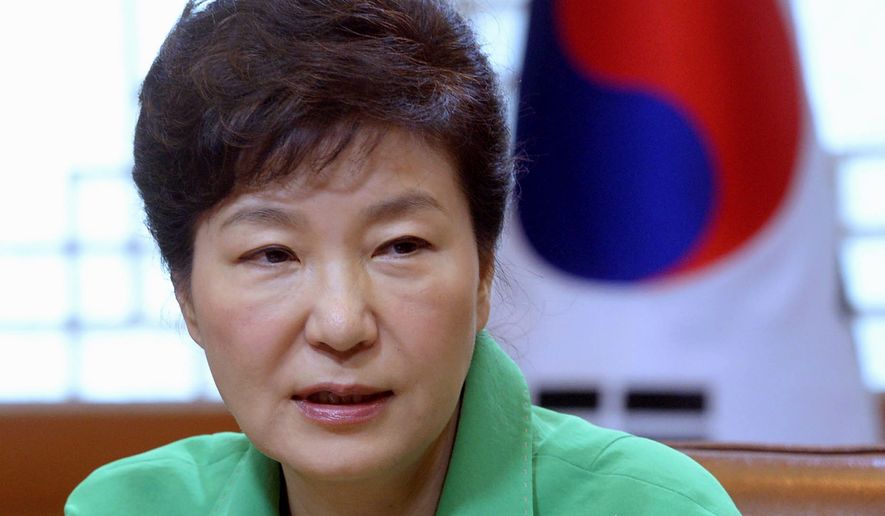President Obama is expected to highlight this week’s U.S. visit by South Korean President Park Geun-hye as an example of the rock-solid alliance between Washington and Seoul — but a range of sticky issues will lurk in the backdrop behind Ms. Park’s visit to the White House at week’s end.
South Korea is not among the 11 nations included in the Obama administration’s highly touted Trans-Pacific Partnership (TPP) free trade pact, but analysts say even more problematic for the relationship is Seoul’s increasing closeness with China.
Not only is South Korea a linchpin of Beijing’s rival Regional Comprehensive Economic Partnership — a separate trade arrangement the Chinese are pushing to counter the TPP — the Park government’s enhanced relations with Beijing carry security implications likely to cause frustration in Washington.
U.S. officials are keen to revamp and modernize the American military footprint in South Korea by using the nation to host a Terminal High-Altitude Area Defense (THAAD) antiballistic missile system.
But Ms. Park has so far been unwilling to endorse the idea, and some suggest the South Korean president’s ambiguous posture reflects her unwillingness to upset China, which sees the THAAD deployment as a threat to their own push for military supremacy over the region.
Richard Fontaine, who heads the Center for a New American Security, said recently that Ms. Park’s government is engaged in a “balancing act” between Washington and Beijing.
It’s a precarious situation that also includes a major role being played by North Korea, of which Beijing has long been seen to be the primary supporter.
The Obama administration has for years sought to convince Chinese leaders to contain Pyongyang’s nuclear ambitions and military posturing. The THAAD issue and the Park government’s reluctance introduce a new complication into such efforts.
Mr. Fontaine argued in a Wall Street Journal op-ed last month that there may be an “impasse” between Washington and Seoul over the THAAD, but that U.S. officials could ultimately turn a blind eye toward South Korea’s increasing closeness to the Chinese on condition that “Beijing begins to make concrete changes to its North Korea policy.”
China aside, the continuing North Korean threat, and the instability it generates throughout the region, are likely to factor heavily in discussions between U.S. and South Korean officials throughout Ms. Park’s visit to Washington.
The South Korean president arrives Tuesday for the four-day visit — her second to the U.S. capital since 2013 — and is slated to meet with officials at the Pentagon before holding talks with President Obama at the White House on Friday.
According to a White House statement, the two presidents will “exchange views on a broad range of security, economic, and global issues, including the U.S.-South Korean alliance and the critical role it plays in assuring regional stability and security.”
Summer of turbulence
The visit comes after a summer of turbulence between Seoul and Pyongyang that featured an exchange of artillery fire and the wounding of two South Korean soldiers in land mine blasts.
The two Koreas have remained technically in a state of war since the 1950-53 Korean War ended in a truce, not a peace treaty. Roughly 30,000 U.S. troops remain stationed in the South — a military presence that stretches back to the United Nations force that repulsed the North’s 1950 invasion.
Ms. Park, meanwhile, was seen to have gotten a lift in domestic polls for the smoothness with which she responded to the latest round of North-South tensions. After two days of talks in late August, negotiators from both North and South agreed to tone down their posturing, hold additional talks and to arrange reunions of families separated by the DMZ.
But more recent actions by the North have dimmed the prospect of a deeper thaw.
Recent days saw Pyongyang mark the 70th anniversary of its ruling party with a massive military parade, replete with thousands of goose-stepping soldiers and military hardware, including missiles and drones mounted on trucks — as well as a declaration by the North’s 32-year-old leader, Kim Jong Un, that the nation is ready to stand against any threat posed by the U.S.
Ms. Park’s visit to Washington is also expected to feature an intensive economic dialogue, with a particular focus on the questions of if and when Seoul may be invited to join the TPP.
The U.S. and 11 other Pacific Rim countries last week agreed on the final terms of a contentious trade pact that cuts trade barriers, sets labor and environmental standards and protects the intellectual property of multinational corporations.
Despite South Korea’s involvement in the alternative 16-nation pact being pushed by China, the Park government has for months requested that Seoul be allowed to join the TPP.
The Obama administration has so far chosen to leave Seoul on the sidelines of the pact, which now faces a tough ratification vote in Congress as well as approval by the other signatories.
If the pact reaches the stage of implementation, analysts say it is likely the U.S. will push for South Korea to be added.
Washington and Seoul already have a bilateral free trade agreement that has been in effect since 2012.
It is also not without precedent that a nation might be party to both the TPP and the China-led pact, known as the RCEP. According to a report by Reuters, seven nations — Australia, Japan, Malaysia, New Zealand, Singapore, Vietnam and Brunei — would be party to both.
• Guy Taylor can be reached at gtaylor@washingtontimes.com.




Please read our comment policy before commenting.